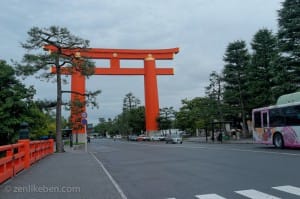Arriving in Kyoto I wasn’t quite sure what to expect. Home to over 1,600 Buddhist temples and 400 Shinto shrines, picking exactly what to visit can be quite the challenge. We stayed at OKI’s Inn, which was fairly centrally located. Near-by was the Heian Shrine so we decided to explore this first.
The Heian Shrine, while not widely listed on any “Must Visit” Shrines in Japan quickly proved it’s worth. While the main shrine itself was incredibly impressive, what I found far more interesting were the gardens.
Heian Shrine

The stepping stones in Heian-jingu garden were the same stones Scarlett Johanson walks over in the movie Lost in Translation
The gardens at the Heian Shrine were broken into four different gardens – West, South, Middle and East.
For 600 yen you start by entering the West garden where the focus is a quiet pond named Byakko-ike. When we were there the gardens were almost empty and a light rain began to fall, creating a very relaxing and peaceful setting to wonder around.
From the West garden you enter the South garden which contain many beautiful cherry trees. Supposedly aristocrats once used this garden to create poems during grand parties that used to be held here.
You then enter the middle garden. It contains the Soryu-ike (Blue Dragon) pond which features the Garyu-kyo, a walkway consisting of stone pillars which once served as foundation stones for the girders of Sanjo Ohashi and Gojo Ohashi, famous bridges in the center of the city of Kyoto. This pathway was also featured in a scene from Lost in Translation.
Finally one enters the East Garden which features a beautiful view across the Seiho-ike (habit of the phoenix) pond to the Taihei-kaku and the Shobi-kan buildings. The Taihei-kaku is a roofed bridge one can walk across and feed the koi and turtles from. A relaxing way to spend the afternoon. From the Heian Jingu Shrine we made our way to the Ginkaku-ji Temple, or Temple of the Silver Pavilion.
Temple of the Silver Pavilion
Ginkaku-ji, while quite small, is famous for it’s sand gardens. It’s popularly called the “Silver Pavilion” because of the initial plans to cover its exterior in silver foil, which were never followed through. The sand garden of Ginkaku-ji has become particularly well known; the carefully formed pile of sand is said to symbolize Mount Fuji and is an essential element in the garden.
While not nearly not as impressive as Kinkaku-ji (“Temple of the Golden Pavilion”), Ginkaku-ji is still a site worth visiting. The sand gardens, the moss garden, and the temple itself radiate in their own beauty.










Enjoyed reading your descriptions of the gardens!